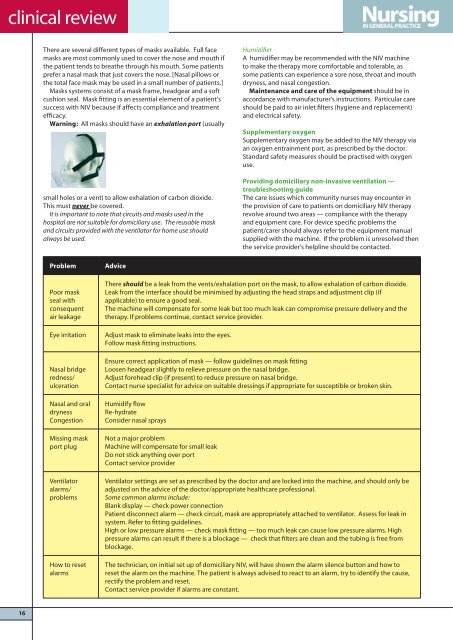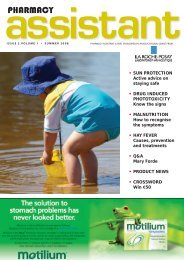veNTIlATIoN - Green Cross Publishing
veNTIlATIoN - Green Cross Publishing
veNTIlATIoN - Green Cross Publishing
You also want an ePaper? Increase the reach of your titles
YUMPU automatically turns print PDFs into web optimized ePapers that Google loves.
clinical review<br />
16<br />
There are several different types of masks available. Full face<br />
masks are most commonly used to cover the nose and mouth if<br />
the patient tends to breathe through his mouth. Some patients<br />
prefer a nasal mask that just covers the nose. [Nasal pillows or<br />
the total face mask may be used in a small number of patients.]<br />
Masks systems consist of a mask frame, headgear and a soft<br />
cushion seal. Mask fitting is an essential element of a patient's<br />
success with NIV because if affects compliance and treatment<br />
efficacy.<br />
warning: All masks should have an exhalation port (usually<br />
small holes or a vent) to allow exhalation of carbon dioxide.<br />
This must never be covered.<br />
It is important to note that circuits and masks used in the<br />
hospital are not suitable for domiciliary use. The reusable mask<br />
and circuits provided with the ventilator for home use should<br />
always be used.<br />
Problem Advice<br />
Poor mask<br />
seal with<br />
consequent<br />
air leakage<br />
<br />
Humidifier<br />
A humidifier may be recommended with the NIV machine<br />
to make the therapy more comfortable and tolerable, as<br />
some patients can experience a sore nose, throat and mouth<br />
dryness, and nasal congestion.<br />
maintenance and care of the equipment should be in<br />
accordance with manufacturer’s instructions. Particular care<br />
should be paid to air inlet filters (hygiene and replacement)<br />
and electrical safety.<br />
supplementary oxygen<br />
Supplementary oxygen may be added to the NIV therapy via<br />
an oxygen entrainment port, as prescribed by the doctor.<br />
Standard safety measures should be practised with oxygen<br />
use.<br />
Providing domiciliary non-invasive ventilation —<br />
troubleshooting guide<br />
The care issues which community nurses may encounter in<br />
the provision of care to patients on domiciliary NIV therapy<br />
revolve around two areas — compliance with the therapy<br />
and equipment care. For device specific problems the<br />
patient/carer should always refer to the equipment manual<br />
supplied with the machine. If the problem is unresolved then<br />
the service provider's helpline should be contacted.<br />
There should be a leak from the vents/exhalation port on the mask, to allow exhalation of carbon dioxide.<br />
Leak from the interface should be minimised by adjusting the head straps and adjustment clip (if<br />
applicable) to ensure a good seal.<br />
The machine will compensate for some leak but too much leak can compromise pressure delivery and the<br />
therapy. If problems continue, contact service provider.<br />
Eye irritation Adjust mask to eliminate leaks into the eyes.<br />
Follow mask fitting instructions.<br />
Nasal bridge<br />
redness/<br />
ulceration<br />
Nasal and oral<br />
dryness<br />
Congestion<br />
Missing mask<br />
port plug<br />
Ventilator<br />
alarms/<br />
problems<br />
How to reset<br />
alarms<br />
Ensure correct application of mask — follow guidelines on mask fitting<br />
Loosen headgear slightly to relieve pressure on the nasal bridge.<br />
Adjust forehead clip (if present) to reduce pressure on nasal bridge.<br />
Contact nurse specialist for advice on suitable dressings if appropriate for susceptible or broken skin.<br />
Humidify flow<br />
Re-hydrate<br />
Consider nasal sprays<br />
Not a major problem<br />
Machine will compensate for small leak<br />
Do not stick anything over port<br />
Contact service provider<br />
Ventilator settings are set as prescribed by the doctor and are locked into the machine, and should only be<br />
adjusted on the advice of the doctor/appropriate healthcare professional.<br />
Some common alarms include:<br />
Blank display — check power connection<br />
Patient disconnect alarm — check circuit, mask are appropriately attached to ventilator. Assess for leak in<br />
system. Refer to fitting guidelines.<br />
High or low pressure alarms — check mask fitting — too much leak can cause low pressure alarms. High<br />
pressure alarms can result if there is a blockage — check that filters are clean and the tubing is free from<br />
blockage.<br />
The technician, on initial set up of domiciliary NIV, will have shown the alarm silence button and how to<br />
reset the alarm on the machine. The patient is always advised to react to an alarm, try to identify the cause,<br />
rectify the problem and reset.<br />
Contact service provider if alarms are constant.










